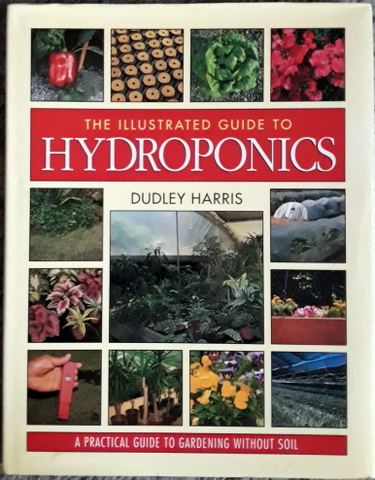I used to be interested in hydroponics and collected quite a number of books about it. My major interest was in the concept of 'organic hydroponics' or the use of naturally occurring materials, balanced in such a way that all of the required nutrients were present, rather than just providing a load of chemicals in solution. I did a bit of mucking around with it, and had a minor degree of success but I needed to do much more research. That is on the back burner at the moment, but I thought others may be interested in knowing what books on the subject were out there, and what they covered.
Gardens Without Soil – Jack Kramer – Charles Scribner and Sons (US) 1976 ISBN 0 684 14425 5 – This book has a large number of B&W photos and line drawings but not a huge amount of accompanying text. Chapter one is an introduction, talking about the advantages of hydroponics (soil-less growing) and what to grow, chapter two talks about how it works, and chapter three goes through what you need in terms of containers, aggregates and nutrient salts. Chapter four gives some more details on nutrient solutions including some formulae, chapter five discusses caring for the plants covering light, temperature, humidity, pests and diseases, chapter six discusses houseplants and their requirements. Chapter seven covers sowing seeds in the system including flowers and vegetables, chapter eight covers growing hydroponics in the greenhouse.
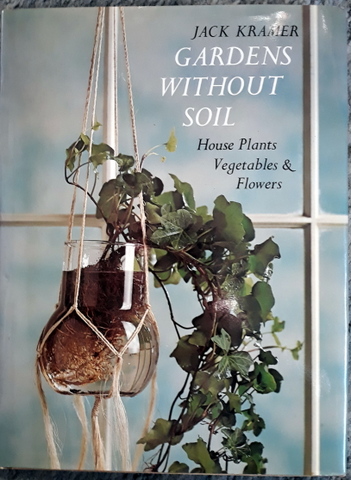
Beginning Hydroponics – Richard E. Nicholls – Running Press (US) 1977 ISBN 0 89471 008 7 – Chapter one is an introduction, talking about the history and science of hydroponics, Chapter two covers various methods of growing hydroponically including basic water culture, sand culture, aggregate culture, the Bengal system and the Mittleider method, as well as several line drawings illustrating some of the methods. Chapter three cover setting up a hydroponics system at home including buying kits, nutrient solutions (some home mixed formulae are included) , and a plant care primer. Chapter four covers what to grow including flowers, vegetables, herbs and other crops, chapter four covers preventing and treating problems such as pests, diseases and nutrient deficiencies (as well as children and plants!). The book has a few line drawings but has a reasonable amount of information.
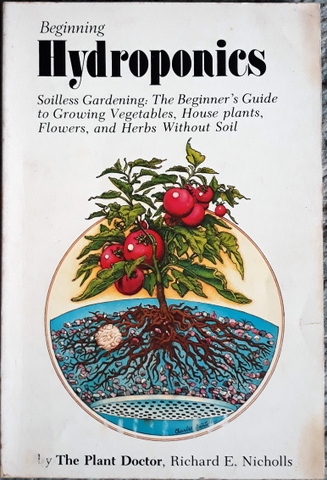
Hydroponic Gardening in Australia – Joe Romer - Reed Books (AUS) 1997 ISBN 978 0 7301 0512 1 – Joe Romer has written a number of books on hydroponics. The initial parts of the book introduce hydroponics, first talking about simple hydroponic systems, then understanding plants and what they require to grow. The next section covers feeding the plants including the difficulties of nutrient mix formulae and the theory behind designing your own mix, followed by discussion of whether to use a medium or non-medium system then how to select a basic hydroponic system to suit your needs. The next section covers how to automate a hydroponic system followed by how to raise seedlings, then how to diagnose problems with seedlings and growing plants. The following section discuss how to grow vegetables, flowers, bulbs and larger plants hydroponically, followed by growing indoor plants and dealing with pests and diseases. There is one set of colour plates near the centre of the book and lots of B&W photos and line drawings.
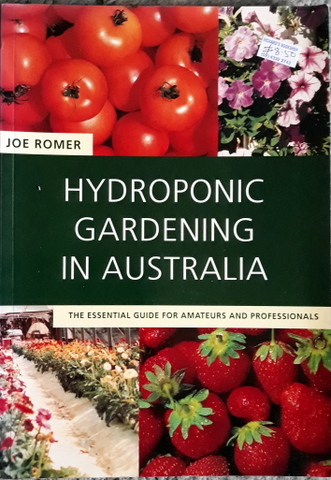
Basic Hydroponics for Everyone – Joe Romer – Shep Books (AUS) 1987 ISBN 978 0 477 01423 2 – This small book was my first book on hydroponics and probably one of my favourites, small but information dense. Each section is small, 3 to 6 pages but detailed. Section one & two are an introduction on what hydroponics is and its advantages, followed by an overview of what you can grow and how to use hydroponics to grow plants indoors. Section five and six talk about simple and commercial hydroponic systems, section seven, providing a controlled environment, section 8 is a short review of materials used to construct the system. Section nine outlines how the backyarder can test their nutrient solutions and section ten provides a summary of what can go wrong and how to deal with it. Section eleven covers selecting your media, section twelve is a review of what plants need to grow successfully, followed by plant propagation, and sections thirteen and fourteen discuss plant nutrients required for successful growth, what they do and effects of deficiency. The next four sections give details on how to grow specific plants: lettuce, tomatoes, strawberries and carnations. Section twenty provides a guide on what plants can be planted when, Section twenty one covers some simple experiments you can perform to learn more about hydroponics. The book has no photos but some line drawings.
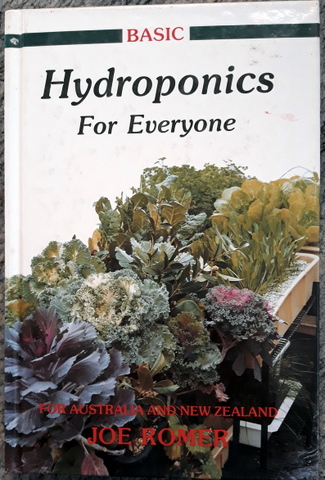
Commercial Hydroponics – John Mason – Kangaroo Press (AUS) 2005 ISBN 0 7318 1256 5 – This is quite a detailed book that is useful to the home based amateur as well as the commercial hydroponics grower. Chapter one covers history, classification of hydroponics systems, an overview of the industry and why be involved. Chapter two talks about site considerations like climate, water and proximity to markets, chapter three looks at alternative media for growing hydroponically and chapter four discusses plant nutrition including preparing nutrient formulae, and solutions, salinity and pH. Chapters five, six, and seven cover various methods of growing hydroponically in detail, Nutrient film technique, rockwool culture and aggregate culture respectively. Chapter eight gives a review of some other techniques like wicking systema nd bag culture, chapter nine discusses equipment required for hydroponics and chapter ten talks about operating hydroponics in a greenhouse. Chapter eleven gives a detailed discussion of growing plants in hydroponics, with chapter twelve talking about vegetable crops, chapter thirteen berry and other fruit crops, chapter fourteen flower crops and chapter fifteen other crops like herbs and indoor plants. Chapter sixteen covers managing a commercial hydroponics farm, including what to grow, crop scheduling and farm layout. Chapter seventeen covers troubleshooting problems with the growing system. The book has an insert of a series of colour plates, plus lots of B&W photos and line drawings.
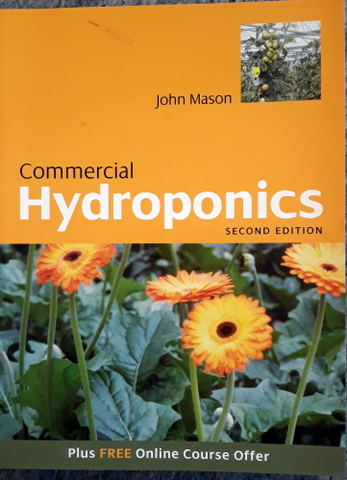
The Complete Guide to Soilless Gardening – Dr Wiliam F. Gericke – Prentice Hall Inc (US) 1945 ISBN 978 1 43670 004 7 – Fascinatingly enough, in 1937 the author of this book invented hydroponics, using it to grow tomatoes in his back yard to 7.6 metres high using a nutrient solution. The book has 277 pages (not including the index), divided into 21 sections, each section containing up to 20 individual subjects so it can be seen that information on each subject is fairly short. There is an introduction followed by details on the various ‘apparatus’ required, a discussion on nutrient solutions and their chemistry, then water, planting and physical conditions (temperature, light, air etc). This is followed by ‘symptoms of change’ a discussion on plant symptoms of nutrient deficiencies, and then discussion of specific requirements for growing tomatoes and other vine crops, potatoes, root vegetables, leaf vegetables, seed vegetables, perennial veg and berries, field crops and flowers of various types. The book finishes off with discussions around commercial, garden and home production, mineral composition of plants, sand culture and the competition between hydroponics and agriculture. The book has a couple of line drawings and a few B&W photos.
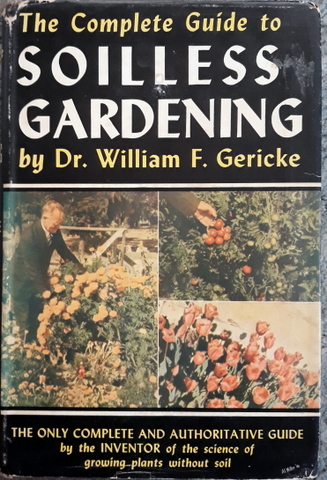
Soilless Growth of Plants – Carleton Ellis & M. W. Swaney, 2nd Edition Tom Eastwood – Reinhold Publishing Corp. (US) 1947 ISBN 978 8 177541 42 7 – Another ‘oldie but goodie’. Boring cover, I guess there was a dust cover that wandered off over the years. The book starts off with a discussion of general plant physiology in chapter one, followed by and overview of different types of soilless culture in chapter two. Chapters three to five give a detailed review of how water culture, sand culture, and gravel culture work including problems, construction details and operation. Chapter six covers nutrient solutions in theory and practice and chapter seven talks about technical control of the nutrient solutions. Chapter eight covers technical control of the plant culture including pumping the nutrient solution and the environment eg air temp., sunlight etc. Chapter nine covers general aspects of plant culture such as propagation, transplanting, harvesting and flushing the gravel. Chapter ten covers diseases, chapter eleven covers special chemicals including soil blocks, manure extracts and thiourea. Chapter twelve covers procedure for analysis of the nutrient solution, mostly using wet chemistry. The book has quite a few line drawings and B&W photos.
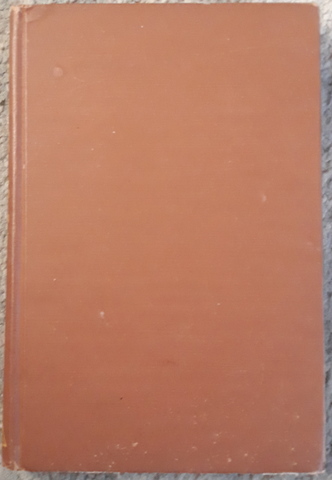
Simple Hydroponics for Australian Home Gardeners – A. C. Sundstrom – Thomas Nelson P/L (AUS) 1979 ISBN 0 17 005331 8 – This one is a relatively small and simple book compared to some of the previous ones. The book starts out with an introduction into what hydroponics is including advantages and disadvantages for the home gardener, followed by methods of operation (media types, containers, and types of hydroponics like vertical, nursery bags and NFT). Design and climate covering things like site selection, rain and wind, temperature etc. followed by factors affecting growth like, mineral elements, water, pH. Chapter five covers nutrient solutions, commercial and homemade, including formulae, chapter six covers running the hydroponic operation and chapter six covers growing operations including planning, sowing times and seedlings. Chapter eight provides details for growing specific vegetable crops and fruit crops. The book has 26 B&W photos scattered throughout and 22 colour plates in four sections.

Beginner’s Guide to Hydroponics – James Sholto Douglas – Pelham Books (UK) 1972 ISBN 978 0 72070 572 0 – This author is quite prolific; I have three of his books in my collection. This book has twelve chapters, most of which are ten pages or less (146 pages in total). Chapter one is an introduction, talking about the meaning and purpose of hydroponics, how it began and how widely it is used (in 1972), Chapter two discusses how hydroponics works and how it differs from soil growing. Chapter three covers setting up simple hydroponic units, chapter four discusses nutrient solutions, including some formulae, chapter five talks about sowing and general requirements for growing healthy plants and chapter six talks about pests and diseases and what to do about them. Chapter seven talks about growing flowers, chapter eight talks about growing fruits and vegetables and chapter nine discusses other hydroponic methods like floating rafts, hanging baskets and mushrooms. Chapter ten reviews designing larger layouts, chapter eleven provides miscellaneous helpful notes food values, further reading and soilless compost and chapter twelve covers other hydroponic systems like sand culture, water culture and aggregate culture. The book has a number of B&W photos and line drawings.
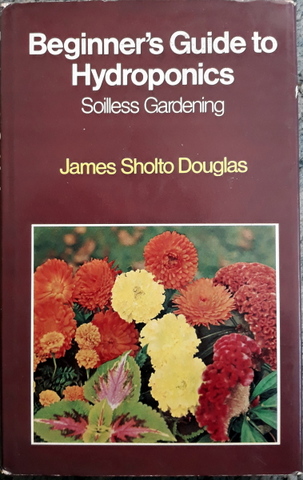
Advanced Guide to Hydroponics – James Sholto Douglas – Pelham Books (UK) 1976 ISBN 0 7207 08 30 3 – This is a much larger and more detailed book than the one above. The book has six parts, which are broken up into a total of twenty five chapters (325 pages in total). Part one is introductory (surprise! surprise!) with three chapters – Chapter one background, experiments and practical developments, chapter two is a general review of systems and methods and chapter three talks about crop physiology. Part two covers unit design and construction discussing the hydroponics site itself, how it should be laid out, overview of water, sand and aggregate culture, irrigation, other miscellaneous techniques, special equipment required and water supply considerations. Part three covers the nutritional formulae, what they are composed of, their usage and application. Part four covers cultural operations, including germination and plant propagation, daily work operations, general cultivation, dealing with deficiencies, pest and diseases, growing vegetables and flowers followed by plantation and other crops. Part five covers solution testing and tissue testing – while great detail is provided in how to conduct the tests you would require some laboratory equipment and a slew of reagents. Part six is ecology and economics covering the influence of hydroponics and costs and returns (circa 1976). This is a well written and very detailed book but probably a bit much for the home amateur. The book has 50 line drawings and other figures plus 18 B&W photos.

Hydroponics: The Bengal System – J. Sholto Douglas – Oxford University Press (UK)1959 ISBN 978 0 19635 271 8 – This book is a small paperback (152 pages in total). This system (developed in Bengal believe it or not!) is also referred to as the ‘run to waste’ system because hydroponic nutrients and not recycled but applied dry or in solution to the top of the hydroponic bed, then washed through the bed to waste by irrigation water or more nutrient solution. The book has ten chapters, chapter one being an introduction covering the history of hydroponics, chapter twois a discussion of how plants grow, and chapter three is a discussion of the materials and equipment required to set up the system and how it is set up. Chapter four covers nutrient mixtures, chapter five discusses how the system works in practice and chapter six discusses general techniques like intercropping, supports, pests and what to look out forin household culture. Chapter seven talks about the commercial possibilities of hydroponics, chapter eight covers deficiencies, pests and diseases, chapter nine is a series of miscellaneous notes about the Bengal system including heating, making non-erodible mud plaster and treatment of seed. Chapter ten discusses the future of hydroponics, as it was seen in 1959. The book has lots of B&W photos and some line drawings.
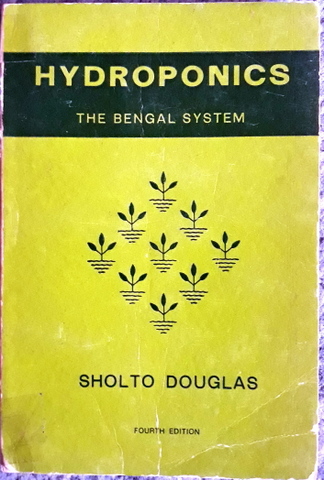
The Hydroponic Hot House – James B. DeKorne – Kangaroo Press (AUS) 1992 ISBN 978 0 86417 523 X – This book is a rewrite of his 1975 book entitled ‘The Survival Greenhouse’ published by Peace Press, it is less detailed that the original but includes some of his experiences since he wrote the original. Chapter one provides an introduction to greenhouses, hydroponics and aquaculture, chapter two provides general information on greenhouse and chapter three talks about a solar greenhouse attached to a dwelling. Chapter four discusses using alternative energy (solar and wind) to power pumps, grow lights and an aerator in the greenhouse, chapter five talks about temperature regulation using vents, wood stove and insulation. Chapter six covers light, its essential qualities and using artificial lighting, chapter seven talks about increasing the carbon dioxide levels in the greenhouse to improve growth, specifically by keeping rabbits. Chapter eight (finally!) discusses hydroponics covering all the usual bits but also mentions hydroponics using organic solutions and using fish tank nutrient solution (aquaponics). Chapter nine covers greenhouse management and how to grow various crops, chapter ten covers insect control and chapter eleven covers aquaculture. The book has a few line drawings and B&W photos.

Hydroponic Home Food Gardeners – Howard M. Resh – Woodbridge Press (US) 1990 ISBN 978 0 88007 178 8 – The book is divided up into four chapters, which are then divided into various topics. Chapter one covers how to choose the best hydroponic system for a home garden. It reviews water culture, NFT, rockwool culture, sawdust culture, perlite and vermiculite cultures, sand and aggregate cultures. Chapter two covers plant nutrition including elements and their function, growing media, sterilisation of the media nutrient solution, water quality, formulations and pH. Chapter three covers backyard greenhouses, but in reality it is just ‘how to construct a Resh greenhouse! Chapter four is about caring for your plants and talks about environmental conditions, pH, growing seedlings, transplanting, spacing, vegetable varieties, pests, diseases and nutritional disorders. The book has lots of B&W photos (especially when assembling the Resh greenhouse), and some line drawings.
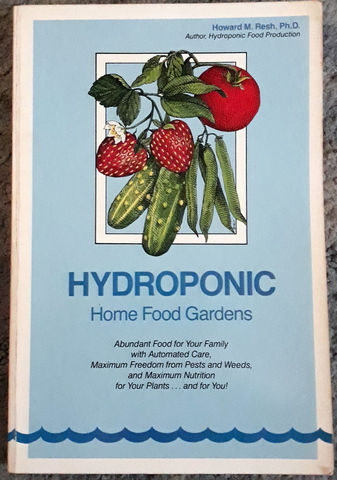
Hydroponic Gardening – Raymond Bridwell – Woodbridge Press Publishing Co. (US) 1972 ISBN 0 912800 09 7 – This book has a foreword by Eddie Albert!!!!! (Remember him? He was an American actor and starred in, among other things, Green Acres back in the ‘60s, look it up if you never saw it). This book has ten chapters, chapter one being an introduction where he extols the benefits of hydroponics, chapter two waffles on about nutrients without really saying anything and chapter three talks about water and pH. Chapter four talks about nutrients including a couple of formulae, chapter five covers growing media but does not give any detail apart from gravel and chapter six covers using hydroponics in a greenhouse. Chapter seven covers planning what to grow hydroponically and chapter eight covers germinating seeds and growing seedlings, and chapter nine talks a bit about techniques of growing hydroponically, like environmental control, pH control, temperature and humidity. Chapter ten covers pests and diseases. The book is written in an irritating conversational style with lots of pointless stories about the authors life. The book has quite a few B&W photos. (not my favourite!)
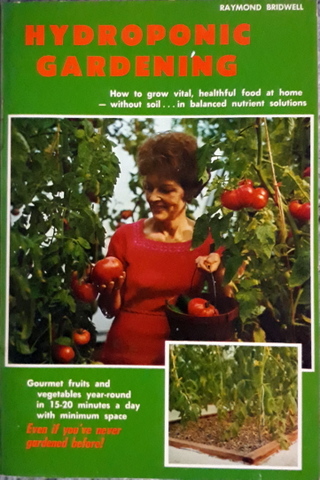
Hydroponic Gardening – Lon Dalton & Rob smith – Cobb/Horwood Publications (NZ) 1984 ISBN 978 0 47309 277 1- This is a fairly small book (112 pages total) with good information but not huge amounts of detail on each topic. The first (Introduction) chapter discusses hydroponic history and advantages of this growing method. Chapter two covers the physiology of how plants grow and is followed by how to grow hydroponically. Chapter four covers a bit of theory around plant nutrients, including 2 formulae and chapter five covers important aspects of hydroponic growing ie oxygen, light and growing media. Chapter six covers the basic operation of the hydroponic system including aggregate, flood and drain and NFT systems. Chapter seven provides a couple of pages on testing nutrient solutions (conductivity mainly), chapter eight talks about the equipment required and chapter nine talks about how to set the system up including manual and automatic systems. Chapter nine provides hints on aspects of running the system and chapter ten covers the process for planting hydroponic systems. This book has lots of colour photos.
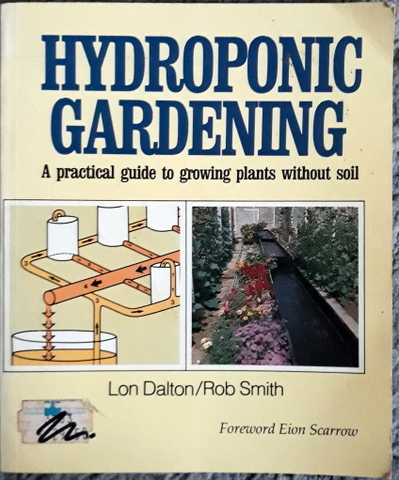
Hydroponic Gardening at Home – Charles E. Sherman & Hap Brenizer – Nolo Press (US) 1975 ISBN (No ISBN) – This is the way out 70’s hydroponics book it looks like, complete with one authors encounter with an (American) Indian medicine man of sorts and a quote from the ‘Essene Gospel of Peace’. Apart from that, the book is divided into three sections, the first being what hydroponics is and how it works including nutrients, organics and the advantages of hydroponics. Section two talks about building and operating a hydroponic gardening including four subsections: The basic elements of hydroponics; greenhouse design; basic elements in action including a description of some simple systems, city and suburban gardens and the ‘ecoshelter’; and, Growing techniques for hydroponics. Section three is about care and feeding of your garden with some description of hydroponic formulae and a couple of pages on organic hydroponics. At less than 100 pages it is not a huge book but does have some interesting information and a whole stack of B&W photos and line drawings.
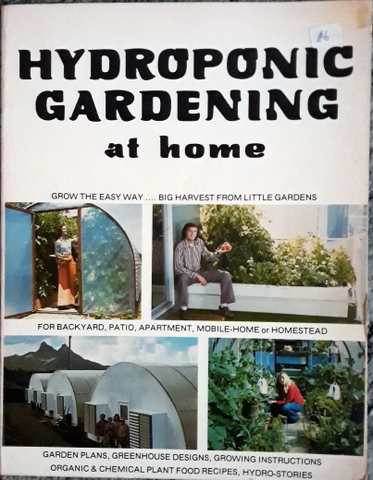
Hydroponic Gardening – Steven Carruthers – Lothian Books (AUS) 1993 ISBN 978 0 85091 557 0 – This book has less than 60 pages and provides a good overview but not a huge amount of detail. After the introduction the book talks about plant nutrition (nutrients pH etc) and then discusses hydroponic media and techniques (water, aggregate, rockwool and sawdust culture) and then discusses the system that can be used (NFT, Flood and drain, drip irrigation, rockwool, aeroponics) and how to pick a system. This is followed by building the various systems, then planting including seed germination, transplanting, nutrient solutions, plant spacing and support. Nutritional and environmental disorders and what to do about them is covered next followed by pest and disease management. This is followed by maintaining the system and ten common questions about hydroponics. The book has lots of colour plates, B&W photos and line drawings.
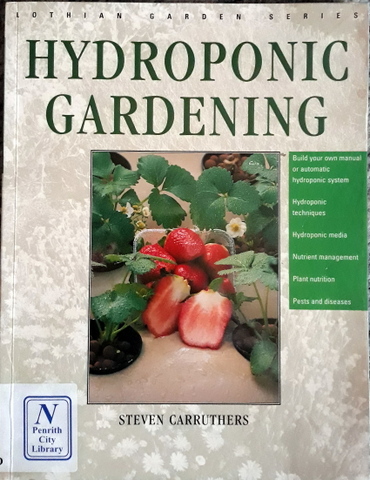
The Illustrated Guide to Hydroponics – Dudley Harris – New Holland Publishers (UK) 1994 ISBN 1 85368 307 8 – Another short (less than 80 pages) A4 sized book that is a good overview but not huge amounts of detail. Most chapters run at about 5 pages each. Chapter one covers what hydroponics is, chapter two talks about plant grow process, chapter three discusses ‘water culture the true hydroponics’ and ideas of how you can set it up. Chapter four discusses setting up a system using small containers, and chapter five covers preparing nutrient solutions with some formulae referred to in appendix four and five at the rear of the book. Chapter six covers growing indoor ornamental plants, chapter seven covers growing in hydroponic beds at home, chapter eight covers growing your own seedlings. Chapter nine covers growing flowers, vegetables and herbs (in 10 pages) and chapter ten covers pests and diseases. Chapter eleven is a Q & A and chapter twelve looks at the future of hydroponics. The book has lots of colour photos and a few colour line drawings.
